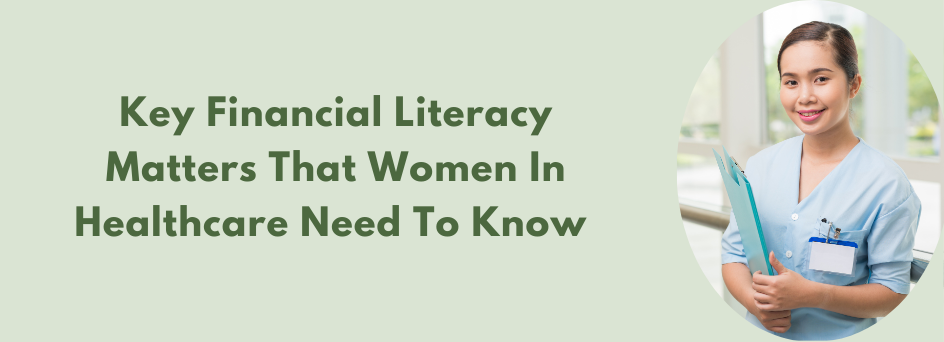Key Financial Literacy Matters That Women In Healthcare Need to Know
In today’s ever-evolving landscape of personal finance, it’s crucial to assess where women in the healthcare sector stand in various financial literacy matters. This article delves into five key areas: saving for retirement, life insurance, long-term care planning, cost of medical care and annuity. Understanding the current status of women’s financial literacy in these domains is essential for addressing potential gaps and empowering women to make informed financial decisions.
Financial literacy is not merely a matter of prudent financial management; it is a crucial life skill that can significantly impact an individual’s future well-being and security.
Financial literacy extends beyond the basic knowledge of managing a budget or saving for a rainy day. It encompasses a good grasp of various financial products and their long-term implications, such as retirement savings — including the high cost of medical care in retirement — and the value of annuities, life insurance and long-term care insurance, among others. Each of these components plays a vital role in shaping a secure financial future, and understanding their value is paramount.
1. Saving for Retirement- the Foundation of Financial Stability

Retirement planning is a cornerstone of financial stability, yet many women in healthcare face unique challenges in this area. While healthcare professions often offer retirement benefits such as 401(k) plans or pensions, women may still lag behind their male counterparts in retirement savings due to factors such as the gender pay gap and career interruptions for caregiving responsibilities.
Financial literacy empowers individuals to make informed decisions about their retirement savings, such as the type of retirement accounts to use (401(k), IRA, Roth, etc.), the amount to save and the investment strategies to employ. Understanding something as simple as the power of compounding interest and the importance of starting early can make the difference between a retirement of comfort and one of financial strain.
In the healthcare field, where women make up a significant portion of the workforce, it’s vital to advocate for equal pay and provide resources and education on retirement planning tailored to women’s needs. Strategies such as maximizing employer-sponsored retirement plans, investing in diversified portfolios, and seeking professional financial advice can help women in healthcare secure their financial futures during retirement.
Learn How to Organize Financial Documents and Keep Them Safe
2. Life Insurance as an Asset- Understand its Strategic Uses

Life insurance is a critical component of financial planning, providing protection and financial security for loved ones in the event of the policyholder’s death. However, research suggests that women in healthcare may be underinsured compared to their male counterparts.
Factors such as lower earning potential and fewer financial resources may contribute to this disparity. Additionally, women’s roles as caregivers within their families may lead them to prioritize the financial needs of their dependents over their own protection.
To address this imbalance, women in healthcare should assess their life insurance needs based on factors such as income replacement, debt coverage, and future expenses. Exploring options such as term life insurance or permanent life insurance policies can provide women with the coverage they need to protect their loved ones and their financial legacy.
In addition, life insurance can be used as a tax-advantaged savings vehicle, leveraging its cash value for retirement income or for estate planning purposes, such as funding a trust to manage wealth transfer or equalize inheritances among heirs. The acceptance of these possibilities truly depends on one’s financial literacy.
3. Long-Term Care Planning- Being Prepared
Long-term care planning is often overlooked but is a critical aspect of financial preparedness, especially for women in healthcare who may be more likely to encounter health-related challenges as they age. Long-term care encompasses a range of services and supports for individuals who require assistance with daily activities due to illness, disability, or cognitive impairment.
According to a 2023 Morningstar article, 70% of people who turn 65 will develop a severe long-term care need in their lifetime; 48% of people who turn 65 will need some type of paid long-term care services in their lifetime. Long-term care insurance can provide financial protection against the exorbitant costs associated with extended care.
Women in healthcare should proactively plan for long-term care needs by exploring options such as long-term care insurance, setting aside savings specifically for future care expenses, and discussing preferences and wishes with loved ones. By addressing long-term care planning early on, women can mitigate financial risks and ensure access to quality care when needed.
4. High Cost of Medical Care- Anticipate and Plan Ahead

The rising cost of medical care poses a significant financial challenge for women in healthcare, especially as they approach retirement. Despite working in the healthcare industry, women may still face financial barriers to accessing necessary medical treatments and services.
Factors such as deductibles, copayments, and out-of-pocket expenses can add up quickly, particularly for those with chronic health conditions or complex medical needs. Additionally, unexpected medical emergencies or procedures can strain women’s financial resources and lead to debt or financial hardship.
To navigate the high cost of medical care, women in healthcare should explore strategies such as maximizing health insurance coverage, utilizing health savings accounts (HSAs) or flexible spending accounts (FSAs) for eligible expenses, and advocating for transparent pricing and affordability measures within the healthcare system.
The cost of medical care, is one of the most underestimated expenses in retirement. According to Fidelity Investments’ 2022 Retiree Healthcare Cost Estimate, the average American couple grossly underestimates their expected cost of health care in retirement to be $41,000. Actually, the average 65-year-old couple retiring this year can expect to spend an average of $315,000 on health care expenses throughout retirement. Financial literacy helps individuals grasp the potential costs involved and the importance of planning for these expenses.
5. Annuity- The Need for Guaranteed Income

Annuities are often-misunderstood financial products, yet they can be a valuable tool in ensuring a steady income stream in retirement. Annuities offer a unique avenue for retirement income, yet healthcare women may not fully understand their potential benefits. Annuities provide a steady stream of income in retirement, offering protection against market volatility. Exploring annuity options tailored to individual needs and risk tolerance can enhance retirement planning for healthcare women.
As pensions have become nearly a thing of the past, financial literacy is crucial in understanding the different types of annuities, their fees and the payout options that can fill the need for predictable income in retirement.
The role of financial advisors: Promoting financial literacy

A financial advisor’s role extends beyond providing investment advice or retirement planning. Advisors are educators and advocates for financial literacy. By imparting knowledge and fostering understanding, they empower clients to make informed decisions that align with their long-term financial goals. With the high demands on assets as we live longer and require more expensive care, financial literacy is not a luxury; it is a necessity. The combination of financial literacy along with the counsel of a financial advisor can provide not only financial well-being, but also peace of mind.
Conclusion
In conclusion, addressing women’s financial literacy in healthcare requires a multifaceted approach that acknowledges the unique challenges and opportunities within the industry. By empowering women with knowledge, resources, and support in areas such as retirement planning, life insurance, long-term care planning, annuity and managing the high cost of medical care, we can ensure greater financial security and well-being for women in healthcare and beyond.
*********
Sheilla Vidal is a Retirement Income Certified Professional RICP® and life insurance broker. Sheilla is also a physical therapist, wife, mother of two, and one of the caregivers for her 86-year-old father. She is an avid learner. She writes, speaks, and recognizes that her work in helping clients live with dignity is her God-given mission.




